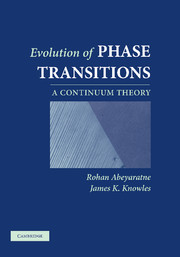Book contents
- Frontmatter
- Contents
- Preface
- Part I Introduction
- Part II Purely Mechanical Theory
- Part III Thermomechanical Theory
- Part IV One-Dimensional Thermoelastic Theory and Problems
- Part V Higher Dimensional Problems
- 12 Statics: Geometric Compatibility
- 13 Dynamics: Impact-Induced Transition in a CuAlNi Single Crystal
- 14 Quasistatics: Kinetics of Martensitic Twinning
- Author Index
- Subject Index
14 - Quasistatics: Kinetics of Martensitic Twinning
Published online by Cambridge University Press: 12 August 2009
- Frontmatter
- Contents
- Preface
- Part I Introduction
- Part II Purely Mechanical Theory
- Part III Thermomechanical Theory
- Part IV One-Dimensional Thermoelastic Theory and Problems
- Part V Higher Dimensional Problems
- 12 Statics: Geometric Compatibility
- 13 Dynamics: Impact-Induced Transition in a CuAlNi Single Crystal
- 14 Quasistatics: Kinetics of Martensitic Twinning
- Author Index
- Subject Index
Summary
Introduction
In the preceding chapter we determined the kinetics of a certain phase transformation using experiments that involved fast loading in which inertia was important. In the present chapter we determine the kinetics of a different transformation using data from quasistatic experiments. The transformation studied here is a twinning deformation, not a phase transformation, a twin boundary being an interface that separates two variants of martensite; see Example 1 in Section 12.2. The change in lattice orientation across a twin boundary makes it analogous, in certain ways, to a phase boundary, and in particular, the motion of a twin boundary is governed by a kinetic relation.
As we have seen, the simplest form of kinetic relation governing the isothermal motion of an interface relates the driving force on it to its normal velocity of propagation: Vn = Φ(f). Since the kinetic response function Φ here is a function of a single scalar independent variable, one set of experiments, say uniaxial tension tests, completely determines Φ; and the function Φ thus determined characterizes all motions of this interface such as, say, in biaxial conditions. If the deformation field is inhomogeneous, and the phase or twin boundary is curved, one would use this same kinetic relation locally, at each point along the interface, relating the driving force at that point to the normal velocity of propagation of that point.
- Type
- Chapter
- Information
- Evolution of Phase TransitionsA Continuum Theory, pp. 221 - 234Publisher: Cambridge University PressPrint publication year: 2006



